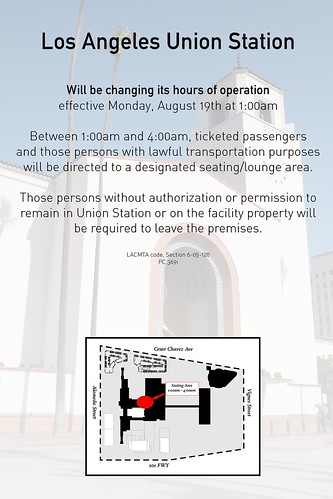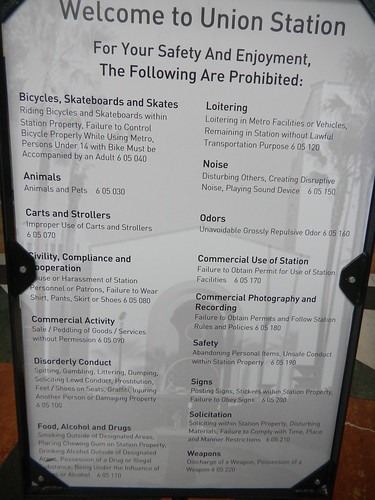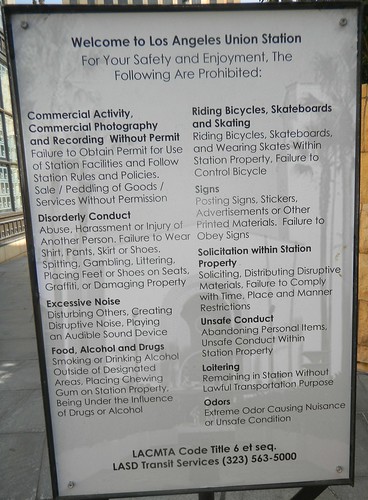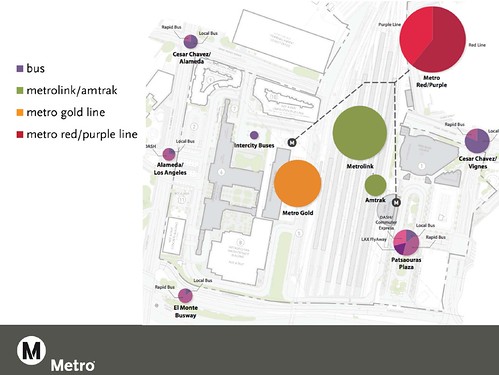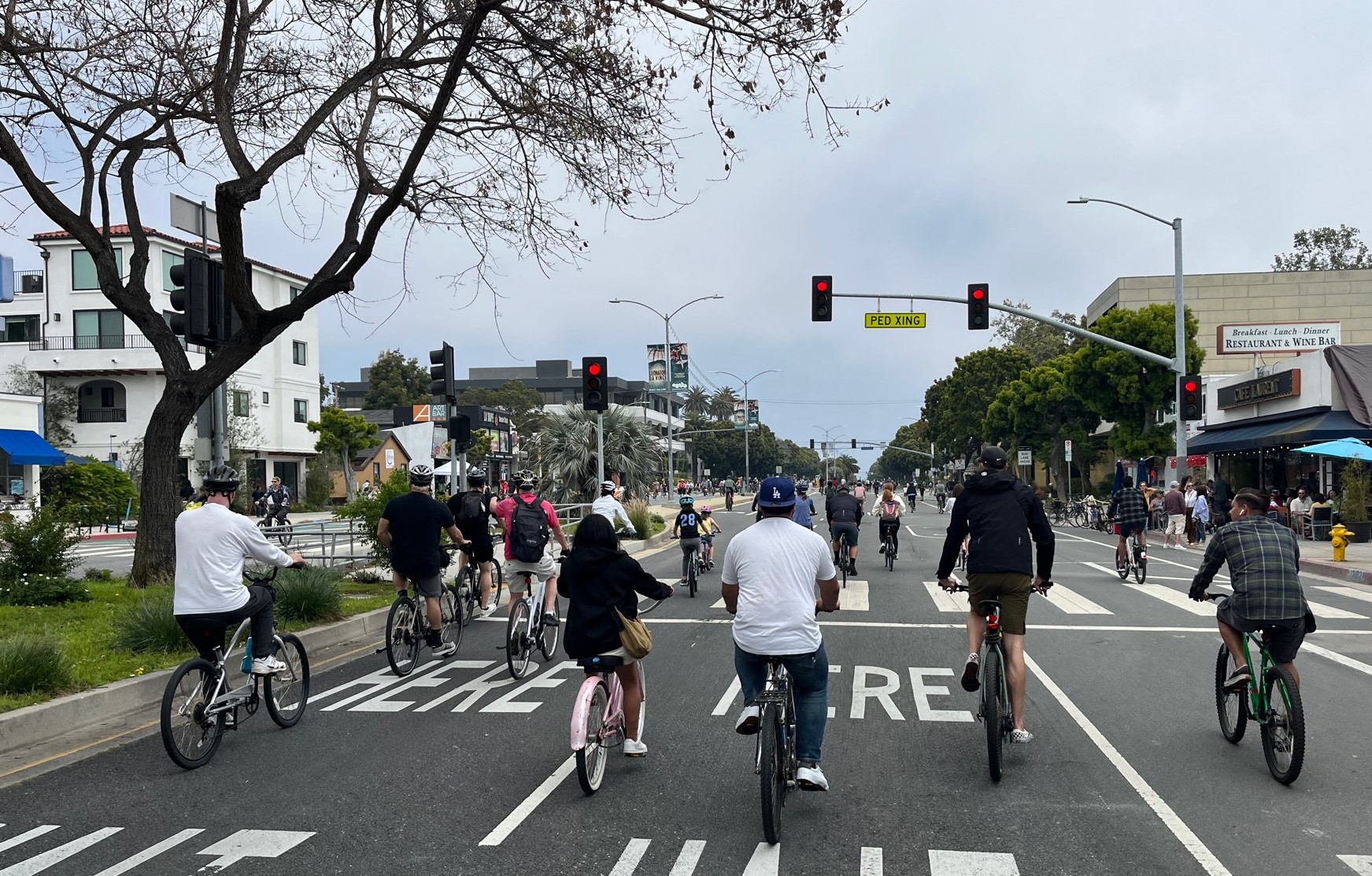As Union Station makes changes, will they consider the people who use it?
12:01 PM PDT on August 21, 2013
On rather short notice, approximately one week ago, Los Angeles Metro announced major changes to the way Union Station will be allowed to be used during the overnight hours of 1am to 4am.
This is one of the many changes public transportation users have begun to see in the wake of Metro’s February 2011 purchase of the station (or “Los Angeles Union Passenger Terminal” to railroading purists) from TPG Capital. TGP Capital had just acquired the property itself through a spinoff deal with ProLogis, which had merged with a development company called Catellus, the descendant company of the Santa Fe and Southern Pacific Railroads’ property holding interests.
While the addition of the newer food and retail options — including the upgrading of the main waiting hall’s newsstand to one operated by the French multinational Relay, as well as the addition of Famima!, Subway, Starbucks, etc. — were begun under the Catellus/ProLogis ownership, further improvements that Metro has proposed will fundamentally alter the interior and exterior of a station that, up until the early 1990’s, had more pigeons than people.
One of the first visible changes made under Metro ownership was the posting early this spring of some directly-quoted portions of the Metro Code of Conduct on signs around the station, including my favorite, the prohibition on “Unavoidable Grossly Repulsive Odor” (6.05.160). This set of regulations, which was adopted in a somewhat off-the-radar method, was originally intended to be applied to the much smaller (and potentially “sealed”) single-purpose rail and bus transit facilities, and vehicles, that were exclusively Metro’s domain.
Before:
Now, apparently, the code is also being applied to all of Union Station, which is a multi-faceted and open facility with all kinds of users and uses that are not taken into consideration on other Metro property. In other words, it appeared that some portions of the code were about to impose Metro’s rules on the customers of other transportation providers and tenants at Union Station even if those carriers and tenants themselves did not also have the same restrictions on their vehicles or at their own stations or in their establishments.
One example was the posting of Metro’s restriction against persons under 14 not being allowed to ride Metro with a bicycle without being accompanied by an adult (6.05.040). This is not the policy of other transportation providers which use Union Station, but by posting it, Metro was essentially banning all persons under 14 with a bicycle who were without an adult from even passing through the station property, even if all they wished to do was buy an ice-cream at Downtown L.A.’s only Ben & Jerry’s.
Fortunately, thanks especially to the work of the Los Angeles County Bicycle Coalition and others, Metro has apparently accounted for some of those conflicts, and has now reposted these restrictions on Union Stations users apparently with the broader context of a modern transportation hub in mind. However, Metro’s code itself is unchanged and it is unclear what portions of it apply to Union Station or if the multiple law enforcement entities that patrol Union Station will be enforcing it.
After:
When the new Code of Conduct signs were installed, another new sign (see image at top of this post) was installed on the reverse side advising that effective Monday, August 19th at 1 am (i.e. earlier this week), the station would be “changing its hours of operation” and:
Between 1:00am and 4:00am, ticketed passengers and those persons with lawful transportation purposes will be directed to a designated seating/lounge area. Those persons without authorization or permission to remain in Union Station or on the facility property will be required to leave the premises.
This sign also contains a map showing where “ticketed passengers and those persons with lawful transportation purposes” are supposed to wait. Roughly, it is the area where one finds the iconic Los Angeles Union Station seats bounded by the Relay Newsstand, the Wetzels Pretzels, the Amtrak information booth and the See’s candy kiosk.
This policy will be enforced by the newly-red-jacketed “Ambassadors in the employ of Universal Protection Service” who are a contractor for Metro specifically assigned to Union Station, in partnership with the Los Angeles County Sheriff Department’s Transit Service Bureau.
To the non-transit-using observer or those who do not work outside of the Monday-Friday 9-5 shift, Union Station might be considered to be “done for the day” once the last Metrolink and Amtrak trains leave and arrive just before Midnight. Certainly it was not all that long ago that the Metro Red Line Subway, which was the only Metro Rail line serving the station, would shut down at about that time.
But Downtown Los Angeles and its transportation hub is slowly turning into a 24/7 activity center.
With the arrival of the Metro Gold Line, and it’s Roybal extension to East L.A. (which converted the “terminal” into a “station”), rail transit at Union Station is a nearly 21-hour operation even on a weekday, due to the logistics of operating a 20-mile (32km)-long light rail line which has only one car-barn. Add in the recently extended Metro service on “Friday and Saturday Nights” and this window grows further.
From my study of the various providers’ current timetables (See combined schedule of operations here) during the traditional work week (Mondays through Fridays) between 12:50am and 4:10am, forty-three arrivals and departures take place at Union Station. On weekends (Saturday and Sundays) that number climbs to seventy-six!
Note that in these totals I have chosen to include the arrivals ten minutes before 1:00am and departures ten minutes after 4:00am as the users of these trips will likely be impacted by the new security policy as they reposition themselves into, out of, or through the Union Station property during the 1:00am to 4:00am time period.
That’s more arrivals and departures on a weekday, than the station saw in an entire day in 1990.
However, it should be remembered that a traveler using Union Station in 1990 would have found themselves using either Amtrak’s trains departing from the railroad tracks or Amtrak’s “Thruway” buses which depart from the Amtrak Bus Bays just west of the Amtrak baggage carousel (located behind the Subway Sandwich Stand).
There was no grand East Portal to the then-gloomy pedestrian tunnel under the train platforms or Patsaouras Transit Plaza beyond. Entry to the tunnel under the strict control of Amtrak personnel and passengers were only permitted access when walking to or from trains.
Passengers were boarded through “gates” along a wall which stretched all the way from the current Amtrak ticket widows to the Amtrak baggage carousel room. You can still see the only remnants of this wall (and passenger-control doctrine) today when you line up, as Amtrak would like you to at most of its stations, for Surfliner departures at the still-intact gates E and F.
Today the station is a vibrant place, and while not nearly as lively as most of its overseas contemporaries (which benefit from their nations’ larger per captia investments in public transportation and special exemptions from local laws on store opening times), Union Station, long the location of a reliably-“stocked” taxi stand, now has retail open 24 hours a day, and has since 1990 added:
- The Subway platform
- The Light Rail platform (in the place of tracks 1 and 2)
- Patsaouras Transit Plaza which hosts transit buses, Megabus and LAX FlyAway Services
- The always-open Gateway Center Garage
- The “Bus Rapid Transit station” where the El Monte Busway meets Alameda Street.
This last facility is currently outside the newly restricted area and it has been there since the El Monte Busway opened in 1974, but it will be replaced in 2015 with a busway platform more adjacent to the Patsaouras Plaza and will then be connected to the rest of Union Station. It is therefore likely to fall under this new control policy when completed, so I have included the departures from it in my survey of timetables, especially since Zev Yaroslavsky would have you accept that the Metro Silver Line (Metro Bus Route 910), which uses it as its Union Station stop, is “like a rail line on rubber tires” and is shown on the Metro Rail Map. Foothill Transit’s Silver Streak bus to West Covina, Pomona and Montclair stops at this facility, shares the same pricing system (fare, media accepted) with the Metro Silver Line as far as El Monte and runs 24 hours per day.
With all of these varying points of egress to and from Union Station property, and with the move via technology from the majority of ticketing being issued on at a staffed window to it now being done through vending machines (scattered around the station property), SMS codes, smartcards, barcodes on smartphones and the coming future of near-field communication (NFC)-enabled devices, the definition of a “ticketed passenger” has changed dramatically in the past two decades.
As I, and many others, have had more than a few Kafkaesque encounters with Metro staff and contractors in the past (how, for example, can one be “ticketed” in advance for a transit bus that uses a farebox?). I turned to Paul Gonzales Metro’s Senior Media Relations Officer for some answers to questions:
Question: If the person is not "ticketed" but wishes to purchase one, are they allowed to stay, and what is the process by which they are permitted access to the various places that tickets are sold with in Union Station? Is merely stating that they will travel considered "transportation business"?
Answer: The desire to purchase a ticket is transportation business, but the person must purchase a ticket. If a person says he/she is waiting for the next conveyance, that qualifies as transportation business. But the person must take that conveyance or they will be required to leave.
Question: At what point before departure will the person be allowed to leave the waiting area to go to their desired transportation departure? Must they wait for an escort as is the case with Amtrak departures today?
Answer: When the conveyance arrives the person should go to the boarding location. Regular Amtrak procedures apply for boarding. [Except Amtrak does not have any trains leaving during this time period-Ed]
Question: What provisions are there for persons wishing to leave the station to, for example, smoke tobacco (take a cigarette break)?
Answer: A person with valid transportation business is allowed in the designated waiting area. A ticket allows the person to enter even if they leave to smoke.
It is understandable that Metro does not want Union Station to become a place that people are either uncomfortable with or afraid to enter, as has been the (thankfully) temporary fate of other large transportation facilities all over the world in living memory. However, it is also incumbent upon the decision-makers at Metro to recognize that there are already many legitimate uses of Union Station in the “wee hours,” and these will only increase in the future. Just because someone is working the third-shift or needs to get somewhere early in the morning does not justify their being hindered in making connections, especially by Metro staff or security contractors who themselves may have never ever traveled by any mode of transport other than a car. There is already a disproportionate amount of scrutiny and intimidation aimed at users of alternative modes of transportation in Southern California than is tolerated by those who use automobiles as it is.
Please let Streetsblog LA know what your experiences are with this new policy as it is implemented.
Stay in touch
Sign up for our free newsletter
More from Streetsblog Los Angeles
Brightline West Breaks Ground on Vegas to SoCal High-Speed Rail
Brightline West will be a 218-mile 186-mile-per-hour rail line from Vegas to Rancho Cucamonga - about 40 miles east of downtown L.A. - expected to open in 2028
This Week In Livable Streets
Active Streets Mission-to-Mission, LAPD reports on its use of force in 2023, Pasadena Transit plans, Metro subway construction, and more
Eyes on the Street: Santa Monica Connection from E Line Bike Path to Downtown Is Almost Complete
“Always be closing gaps in your bikeway network.”
CicLAvia Opens Venice Boulevard – Open Thread
CicLAvia opened six miles of Venice Boulevard - from Culver City Station to Venice Beach
